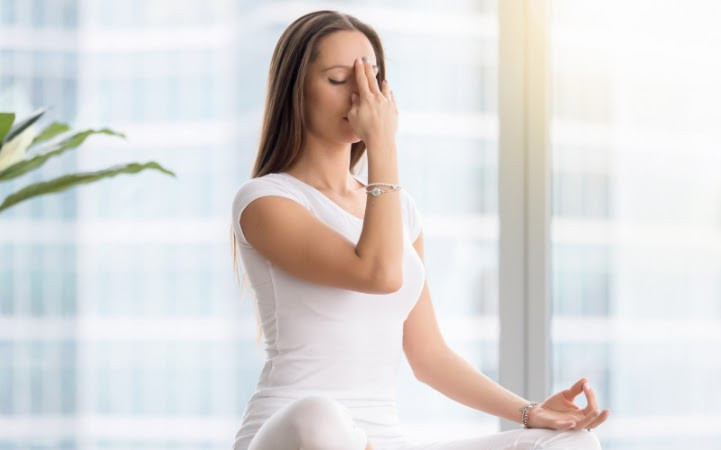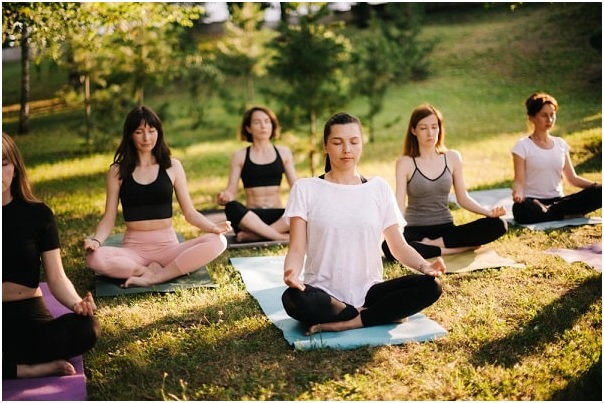

Yoga is a comprehensive system of physical, mental, and spiritual practices that originated in ancient India. It has evolved over thousands of years and encompasses a wide range of techniques and philosophies. The word “yoga” itself is derived from the Sanskrit word “yuj,” which means to yoke or unite, reflecting the goal of uniting the mind, body, and spirit.
Yoga therapy includes :
1. Asanas (Physical Postures): Yoga includes a variety of physical postures or asanas designed to improve flexibility, strength, and balance. Examples include downward dog, tree pose, and warrior poses.
2. Pranayama (Breath Control): Pranayama involves breath control exercises that focus on conscious breathing. It helps regulate and deepen the breath, promoting relaxation and increased awareness.
3. Meditation: Meditation is a central aspect of yoga that involves training the mind to achieve a state of focused awareness or mindfulness. This can be done through various techniques, including guided meditation, mindfulness meditation, mantra meditation etc.
4. Dhyana (Deep Meditation): Dhyana is the practice of deep meditation, where the practitioner experiences a state of profound concentration and heightened awareness.
5. Yamas and Niyamas (Ethical Guidelines): These are ethical principles and guidelines that form the foundation of yogic philosophy. Yamas include principles like non-violence and truthfulness, while niyamas include practices like self-discipline and contentment.
6. Mantras and Chanting: Mantras are sacred sounds, words, or phrases that are repeated during meditation or chanting. They are believed to have spiritual and vibrational significance.
7. Yoga Philosophy: Yoga is rooted in a rich philosophical tradition, including texts like the Yoga Sutras of Patanjali. The philosophy encompasses principles such as the eight limbs of yoga, which include ethical guidelines, physical postures, breath control, and meditation.
8. Hatha Yoga: This is a branch of yoga that focuses on physical postures (asanas) and breath control (pranayama). Hatha yoga is often used to describe the practice of physical postures in general.
9. Vinyasa Flow: This style of yoga emphasizes the connection between breath and movement. It involves a dynamic sequence of postures, and the transitions between poses are coordinated with the breath.
10. Kundalini Yoga: Kundalini yoga focuses on awakening the dormant spiritual energy at the base of the spine. It involves dynamic movements, breathwork, and chanting.
11. Restorative Yoga: This style is designed to promote relaxation and rejuvenation. It typically involves passive poses supported by props, allowing the body to release tension.
Benefit of yoga:
1. Improved Flexibility: Yoga involves a series of poses and stretches that help improve flexibility by targeting various muscle groups and joints.
2. Increased Strength: Many yoga poses require you to support your body weight in different ways, leading to improved strength and muscle tone.
3. Enhanced Posture: Regular practice of yoga can help correct and improve posture by strengthening the core muscles and promoting body awareness.
4. Stress Reduction: Yoga emphasizes mindfulness, deep breathing, and relaxation techniques, which can reduce stress and promote a sense of calm.
5. Better Balance: Yoga poses often involve balance and coordination, helping to improve stability and prevent falls, especially as you age.
6. Improved Breathing: Yoga incorporates various breathing exercises (pranayama) that enhance lung capacity, increase oxygen intake, and promote better respiratory health.
7. Increased Energy Levels: The combination of physical movement, breath control, and meditation in yoga can boost energy levels and reduce feelings of fatigue.
8. Enhanced Mental Focus: The practice of mindfulness in yoga can improve concentration and mental clarity, leading to better focus in daily activities.
9. Pain Relief: Yoga has been found to be beneficial for managing and reducing chronic pain, particularly in conditions like lower back pain and arthritis.
10. Emotional Well-being: Yoga encourages self-awareness and introspection, fostering emotional well-being and providing tools to cope with stress, anxiety, and depression.

Meditation is a practice that involves focusing the mind and eliminating distractions to promote a state of relaxation, concentration, and heightened awareness. It has been used for centuries as a means to cultivate mental clarity, emotional well-being, and spiritual insight. There are various meditation techniques, but most share common elements such as focused attention, controlled breathing, and a quiet environment.
Benefits of Meditation:
1. Stress Reduction: Meditation can help reduce stress by promoting relaxation and calming the nervous system.
2. Improved Focus: Regular meditation practice has been linked to enhanced attention and concentration.
3. Emotional Well-Being: Meditation may contribute to emotional well-being by reducing symptoms of anxiety and depression.
4. Mind-Body Connection: Meditation can help strengthen the connection between the mind and body, fostering a greater sense of awareness.
5. Better Sleep: Meditation has been associated with improved sleep quality and may help with insomnia.
6. Increased Self-Awareness: Through meditation, individuals can develop greater self-awareness, understanding their thoughts and emotions more deeply.
7. Spiritual Growth: For many, meditation is a spiritual practice that fosters a sense of connection and inner peace.

Pranayama is a key component of yoga that involves breath control and regulation. The term “pranayama” is derived from two Sanskrit words: “prana,” meaning life force or vital energy, and “ayama,” meaning to extend or regulate. Pranayama techniques focus on conscious manipulation of the breath to enhance physical, mental, and spiritual well-being.
Benefits of Pranayama:
1. Stress Reduction: Pranayama promotes relaxation and helps reduce stress by activating the parasympathetic nervous system.
2. Improved Respiratory Function: Regular practice enhances lung capacity, strengthens respiratory muscles, and improves overall respiratory efficiency.
3. Enhanced Focus and Concentration: Pranayama techniques encourage mindful awareness and can enhance concentration.
4. Balanced Energy Flow: Pranayama is believed to balance the flow of prana (life force energy) throughout the body.
5. Calmness and Emotional Well-Being: Certain pranayama practices, such as Nadi Shodhana, are known for promoting emotional balance and a sense of calm.
6. Detoxification: Deep breathing techniques, like Kapalabhati, are thought to support detoxification by increasing oxygen exchange and facilitating the removal of toxins.
7. Mind-Body Connection: Pranayama fosters a deeper connection between the mind and body, promoting overall well-being.